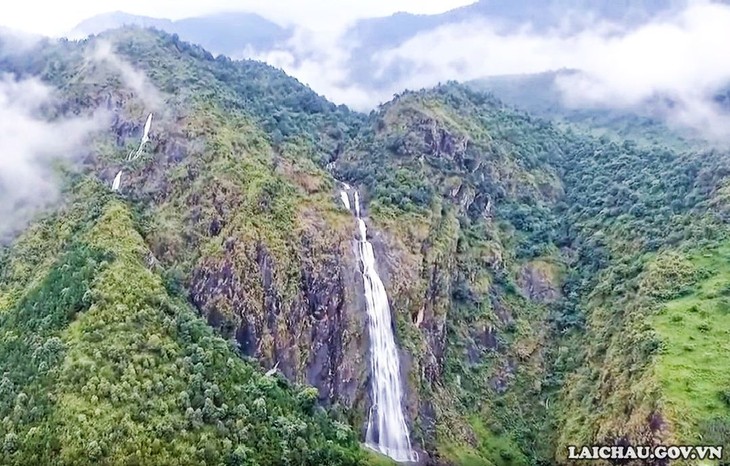Lai Chau is Vietnam’s northwest province, bordering China’s Yunnan province. It’s endowed by nature with a superb landscape and has a number of famous historical sites.

A corner of Pu Sam Cap complex in Lai Chau city (Photo: Kim Anh)
Nature has endowed Lai Chau province with impressive physical features like Pu Sam Cap cave, Gia Khau cave, and Phieng Phat hot spring.
There are 25 relic sites, including 5 national relic sites – the Tien Son historical site in Tam Duong district, the King Le Thai To memorial site (formerly the King Le Loi stele) in Nam Nhun district, the Pu Sam Cap complex in Lai Chau city, the Nam Tun relic site in Phong Tho district, and the Cau May Waterfall and the Heaven Gate in Tam Duong district.
Tran Quang Khang, Deputy Director of the Department of Culture, Sports and Tourism, said: “Lai Chau province has stunning passes, terraced fields, hydro-power reservoirs, and 6 of the 10 highest mountain peaks in Vietnam. In the forests are rare plants, streams, waterfalls, ancient tea trees, and Azalea. We are developing adventure tourism and mountain trekking to exploit our natural resources. We hold an annual paragliding tournament in Si Thau Chai village, Tam Duong district. In the future we will establish the Lai Chau Paragliding Club and train pilots who are indigenous people to lead paragliding activities.”
Pu Sam Cap cave, considered by many to be northwest Vietnam’s best cave, contains colorful stalactites with unique shapes.

Tac Tinh waterfall (laichau.gov.vn)
Tac Tinh waterfall in the majestic Hoang Lien Son range drops from a height of more than 100 meters. From afar the waterfall looks like a white silk ribbon against the green forest. If you ask, local people will tell you a heart-warming legend about this waterfall.
O Quy Ho pass stretches 50 km, connecting Lao Cai and Lai Chau province. It is considered one of the 4 most dangerous passes in the northwest region, along with Pha Din, Khau Phạ, and Ma Pi Leng pass. The Rồng Mây Glass Bridge is a massive tourism complex near O Quy Ho Pass.
Nguyen Thu Phuong, a team of the complex, said: “On weekdays, we welcome mainly Vietnamese tourists. On weekends we have more foreign tourists, who come from Thailand, South Korea, Japan, China, Israel, and India. The COVID-19 epidemic has been basically controlled, so foreign tourists come more often. We might see 2,000 to 3,000 tourists on the weekends.”

The Rong May Glass Bridge (Photo: Ngoc Anh)
The O Quy Ho Heaven Gate is another tourist attraction. From this spot you can see a vast sea of clouds, mountains, forests, and terraced fields.
Nguyen Ba Nam, a tourist from Hanoi, said: “I’ve come to Lai Chau province before, but this is the first time I’ve visited O Quy Ho. The scenery is magnificent and romantic. I visited the Rong May Glass Bridge and the O Quy Ho Heaven Gate. The Rong May Glass Bridge is a huge, beautiful construction. There is a rope suspension bridge, which gives you a strange feeling when you walk on it. I will return to Lai Chau province if I get the chance.”
Tan Uyen tea hill, where delicious tea varieties like Shan Tuyet, O Long, and Thanh Tam are grown, is a favorite photo spot of many tourists. Covering about 2,000 ha Tan Uyen tea hill amazes visitors with its endless tea fields stretching to the horizon.
Lai Chau province has 11 community tourism hamlets following 5 national community-tourism models: San Thang in Lai Chau city, Sin Suoi Ho, Vang Pheo in Phong Tho district, and Hon and Si Thau Chai in Tam Duong district.
Sin Suoi Ho wants to become the typical tourism hamlet of ASEAN. Mai Thi Hong Sim, Vice Chairwoman of Phong Tho district People’s Committee, says: “In 2019 Sin Suoi Ho was recognized as one of four national typical tourism hamlets and a 3-star OCOP tourism product of Lai Chau province. In addition to cultural activities, tourists can trek to the Trai Tim waterfall and the Bach Moc Luong Tu summit, one of the most beautiful mountain peaks in Lai Chau. Following the stone path from Sin Suoi Ho and Bat Sat district is a fantastic experience.”
Ngoc Anh